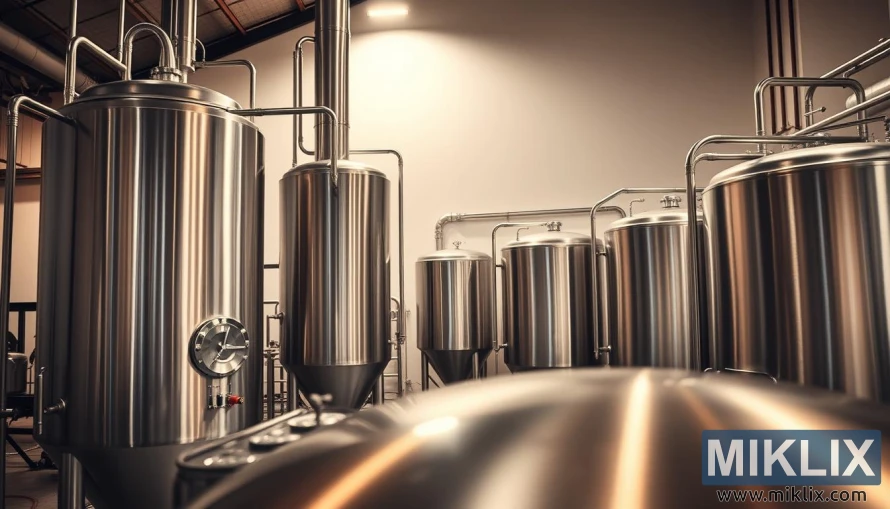Image: Industrial Rye Brewing Equipment
Published: July 24, 2025 at 7:35:45 AM UTC
Last updated: September 27, 2025 at 5:31:47 PM UTC
A sleek brewhouse interior featuring polished rye brewing tanks, mash tun, and fermentation equipment in a well-lit, modern setting.
Inside this impeccably maintained industrial brewhouse, the image captures a moment of quiet intensity and technological elegance. The space is defined by its gleaming stainless steel surfaces, each vessel and pipe polished to a mirror-like finish that reflects the warm, ambient lighting overhead. The composition is anchored by a massive mash tun in the foreground, its cylindrical body and domed lid commanding attention. The tun’s surface glows with a soft golden sheen, hinting at the heat and energy within, where rye grains are steeped and stirred in a carefully controlled environment. This vessel is the heart of the operation, where starches begin their transformation into fermentable sugars, and where the character of the beer begins to take shape.
Flanking the mash tun are two equally imposing structures: a towering lauter tun and a robust brew kettle. Their angular silhouettes and complex network of valves, gauges, and insulated piping speak to the precision required in rye beer production. Rye, with its high beta-glucan content and dense husk structure, demands careful handling to avoid stuck mashes and ensure proper lautering. The equipment here is clearly designed with that challenge in mind—engineered to accommodate the unique properties of rye while maintaining efficiency and consistency. The brew kettle, slightly offset and partially obscured by steam, suggests the next stage of the process: boiling the wort, adding hops, and driving off unwanted volatiles. Its presence adds a sense of momentum, a visual cue that the brewing cycle is in full swing.
In the middle ground, a row of fermentation tanks lines the wall with geometric precision. Their conical bottoms and cylindrical bodies are not just aesthetically pleasing—they’re functional, designed to facilitate yeast collection and sediment removal. Each tank is connected to a web of pipes and digital control panels, allowing for real-time monitoring of temperature, pressure, and fermentation activity. The tanks gleam under the soft lighting, their surfaces unmarred and their fittings tightly sealed, suggesting a facility where cleanliness and control are paramount. The symmetry of their arrangement adds to the sense of order and discipline, reinforcing the idea that this is a space where every detail matters.
The background fades into a soft, diffused glow, revealing structural beams and high ceilings that give the brewhouse a sense of scale and openness. The lighting here is more atmospheric, casting gentle shadows and highlighting the architectural lines of the facility. It creates a sense of depth and continuity, drawing the eye from the foreground vessels to the distant corners of the space. This subtle interplay of light and shadow adds a layer of sophistication to the image, suggesting that the brewhouse is not just a place of production, but a temple of craft.
Overall, the image conveys a mood of reverence and innovation. It celebrates the complexity of rye brewing, a process that requires not only technical expertise but also a deep understanding of the grain’s behavior and potential. The equipment is both beautiful and functional, a testament to the brewer’s commitment to quality and creativity. From the polished mash tun to the silent fermentation tanks, every element in the scene contributes to a narrative of precision, passion, and the pursuit of flavor. This is not just a brewhouse—it’s a laboratory of taste, a sanctuary of process, and a monument to the art of brewing rye beer.
The image is related to: Using Rye as an Adjunct in Beer Brewing

